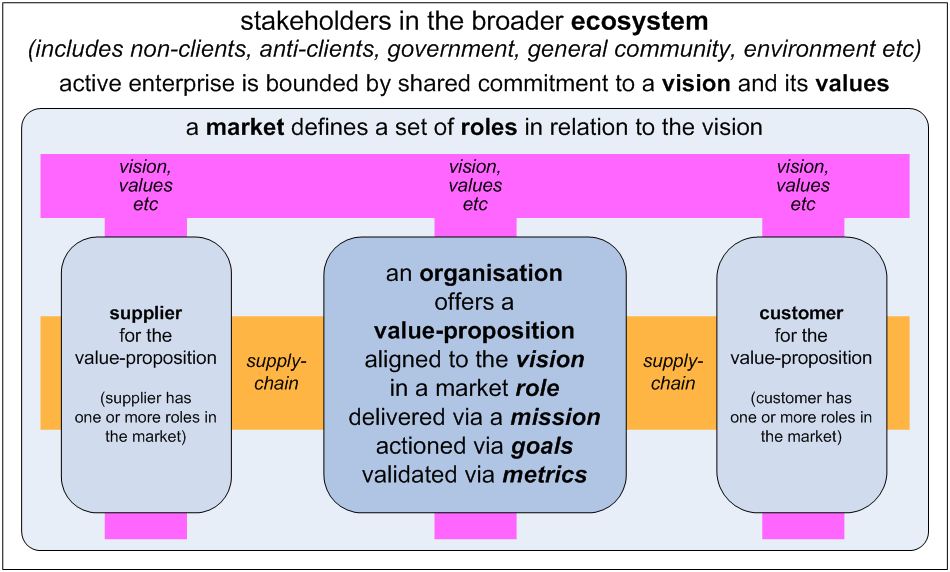Service-design: How long is a service?
It was my grandmother’s 80th birthday. My parents wanted to make it a special occasion for her and for the family, so they booked us in for a meal at a place called Le Talbooth – then, as now, a decidedly upmarket restaurant beside the River Stour, on the border between Essex and Suffolk counties in south-east England.
Back in those days, Le Talbooth only did a fixed menu, with the only choice between meat or fish, and with everything booked in advance. But one of our extended-family was vegetarian – at that time still regarded as a bit unusual, even a bit eccentric – so we had to warn the restaurant that we needed a different dish in her case.
So come the day, there we all were, in the grand private room of the restaurant. After the starters, out came the main course – meat or fish, as per the pre-agreed plan. And out came one of the serving-staff, who asked, somewhat diffidently, “I understand one of your party is vegetarian?” She duly raised a hand, awaiting the usual tired omelette or baked-potato that was often all that a vegetarian could expect back then. Oh well.
But that wasn’t what came up in this case. Instead, the kitchen had gone wild. They’d gone crazy. They’d obviously had a lot of fun. Because what was wheeled out, with some pride and ceremony, was an entire trolley-load of vegetarian treats – much of it food that most of us had never seen or heard of before, let alone tasted. Wow! I think every one of us turned vegetarian on the spot! – for the day, at least!
That was quite a long time ago – more than four decades ago now, in fact. But the memory of superb service from that restaurant still lives on, even that far back into the past.
Which, by a roundabout route, brings us to a key question for service-designers: how long does a service-instance last? What’s its actual duration?
The usual view of service-instances is organisation-centric:
- the service-instance begins when the customer comes into the organisation’s space, with the initial service-request
- the service-instance ends when the customer leaves the organisation’s space
But as with all business-centrism in business-architecture and enterprise-architecture, that view risks missing the point here – and often dangerously so. An organisation’s value-proposition isn’t solely about its products or services: far more, it’s about how those products or services can help customers, providers, employees and everyone else to reach towards a shared-story – ‘the enterprise’ not as an organisation, but as a literal ‘bold endeavour’, shared with all others in that story’s space. Services are thus a means to reach towards satisfying the drivers for the story:
On the surface, and for the organisation, yes, service-delivery might appear only as the ‘horizontal’ supply-chain path on that diagram above, with the service-instance starting and ending as it transits the boundaries and timelines of the organisation itself. In effect, that’s service viewed solely as ‘how’ and ‘with-what’.
Yet the drivers for the service – the ‘why’ for service – are actually in the shared ‘vertical’ links between each party and the same overarching story, as on that diagram above. That’s how the connection is made: that’s where marketing and branding sit, for example, and why branding is so strongly oriented towards story – towards creating a meaningful story about a means to satisfy a perceived or actual need.
And it’s in that ‘why’ that we also find the criteria for success in service-delivery. We see it especially in experiences such as in our family’s story above, where the expectations of service were not only met, but far exceeded, in ways that – as in our case – may literally ring on down through the generations.
We could probably say much the same, if in less happy ways, about disservices – supposed ‘services’ that fail to deliver to the actual need. For example, consider this (mildly-redacted) item that came up from a US colleague in my Twitter-feed this morning:
- Anybody else get [restaurant-chain’s] sticker shock yet? Monster price hike for take out. 2 dishes and appetizer $42. Seriously? It’s not that good.
Again, the key here is that certain expectations were set, by the organisation’s engagement in that story – and those expectations were not met. Definitely not met. Okay, the disgruntlement there may not sit for decades, as did our contrasting enjoyment of that family-occasion. Yet it still represents a real kurtosis-risk, and one that could well destroy the organisation’s business if left to repeat too often or fester too long – especially in these days of social-media, where a single anticlient-Tweet can easily echo halfway round the world…
So to make sense of the true life-cycle of service-instances, we need to shift our view of services themselves, from an organisation-centric perspective, to the perspective of the service-customer.
(Technically the correct term is ‘service-consumer’, of course – but I strongly object to that term ever being applied to real people!)
In which case, if we use this example above, of my grandmother’s birthday-dinner at Le Talbooth, then:
- The service-instance begins when the customer first engages in the story. In this case, that occurred when my parents first decided that they’d like to celebrate that anniversary – which would have been quite some while before they even thought of contacting Le Talbooth to enquire about a booking.
- The service-instance ends only when no-one remembers it any more. In this case, that service-instance is still continuing today – more than forty years later – because we still remember it.
In effect, the quality of service-delivery continues to be re-assessed, indefinitely, until it is finally forgotten. It’s that factor that drives anticlient-impacts and the like – or, on the positive side, that likewise underlies more directly-measurable impacts such as Net Promoter Score.
Try it: what difference does it make for service-design if you shift the perspective from organisation-centric to customer-centric? Let me know in the comments, perhaps?


Leave a Reply